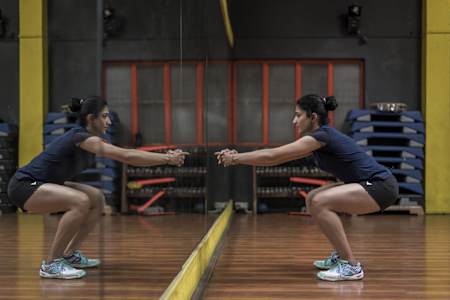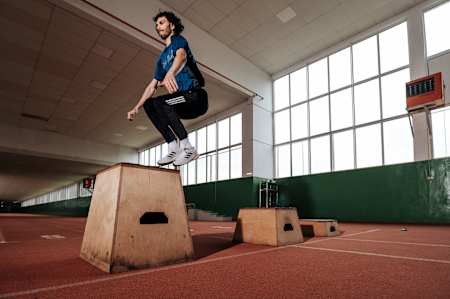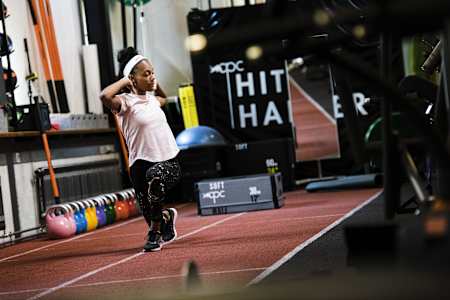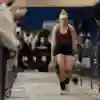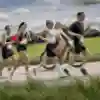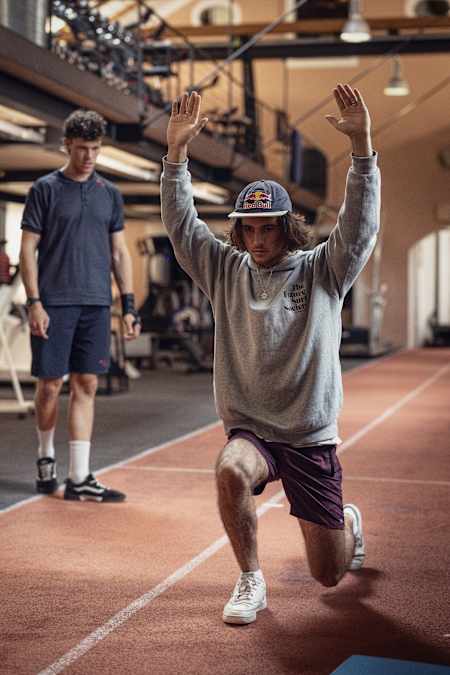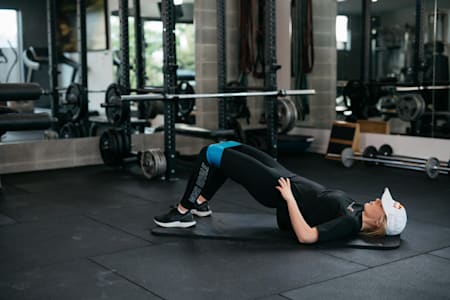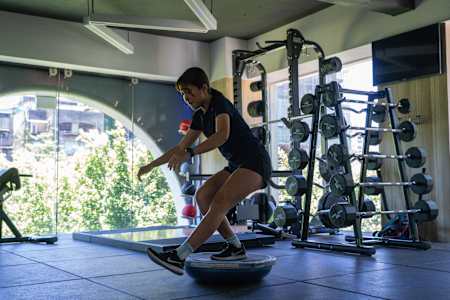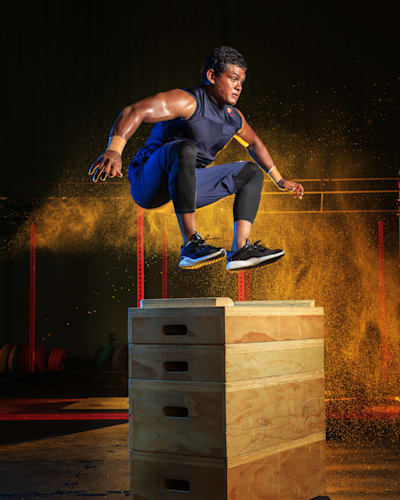
Fitness Training
Build stronger legs anywhere, anytime: 10 callisthenics workouts for all
Discover the essential leg exercises perfect for athletes of any level. Build strength without using weights by leveraging your own bodyweight.
Unlock the secrets to building stronger legs and enhancing your performance without ever stepping foot in a gym - with callisthenics. Our comprehensive guide explores 10 transformative bodyweight exercises that target every muscle in your lower body – from the explosive power of your quads to the enduring strength of your hamstrings.
Each movement, like the Bosu Lateral Jump Squat, is designed to not only improve your muscle tone and coordination, but also to boost your overall fitness level.
What is callisthenics?
The main idea of callisthenics is to combine bodyweight and the force of gravity to create the resistance needed for training. When this training is focused on the legs, it generates testosterone, which helps with muscle gain and fat loss, reduces the risk of injury, and generates more power for the body, as athletes explain.
How do you build leg strength with callisthenics?
Simple modifications, such as adding a rotation to your squat, can elevate the challenge and effectiveness of your workout. Whether you're a dedicated athlete looking to gain an edge or a beginner aiming to build foundational strength, these exercises provide the tools you need for profound physical progress, all from the comfort of your home.
How to increase leg strength with bodyweight?
01
Bosu lateral jump squat
- Key benefits: Improves multi-directional agility and coordination.
- Common mistakes: Not landing softly to absorb impact.
- Variations: Increase difficulty by adding a rotation on the Bosu.
The Bosu lateral jump squat is an intensive exercise that targets the strengthening of leg muscles through dynamic lateral movements and squats. Start by placing a Bosu ball with the flat side up next to you. Stand on your left foot beside the Bosu and then explosively jump sideways onto it with both feet, landing in a squat position. Ensure your knees are bent and your back remains straight. Push off with your legs to jump back to the starting position and repeat on the opposite side.
This exercise not only strengthens the quadriceps, hamstrings and glutes, but also improves lateral movement agility and balance, making it highly beneficial for athletes involved in sports requiring multi-directional speed.
02
Free squat
- Key benefits: Engages core stability and increases lower body strength.
- Common mistakes: Allowing the knees to extend beyond the toes, which can strain the knees.
- Variations: Introduce pause squats or pulse squats for increased intensity.
Ashwini Ponnappa squats in front of a mirror to master her movement
© Ali Bharmal/Red Bull Content Pool
Stand with your feet slightly apart, keeping your back straight. Bend your knees and push your hips back to lower into a sitting position, while simultaneously extending your arms forward. Make sure your heels stay firmly planted on the ground. Return to a standing position and lower your arms to your sides. Free squats primarily target the quadriceps, hamstrings and glutes. Additionally, they engage the core for strength and stability, enhance ankle mobility and strengthen the back muscles and calves.
03
Box jumps
- Key benefits: Boosts cardiovascular fitness and enhances explosive power.
- Common mistakes: Failing to land with knees slightly bent.
- Variations: Alternate heights or add lateral movements to challenge agility.
Select a box at a comfortable height, ideally placed no more than 60cm in front of you. Swing your arms backwards and then quickly forward to generate momentum, and explosively jump from the ground. Land softly on the box with your knees bent and then straighten to stand fully. Descend by either jumping down gently or stepping down one leg at a time.
High jump specialist Tihomir Ivanov is an expert at the squat jump
© Ivaylo Donchev/Red Bull Content Pool
Box jumps are a dynamic plyometric exercise that strengthens your glutes, quadriceps, calves and hamstrings. This exercise not only enhances your speed, power and explosiveness, but also elevates your heart rate, facilitating calorie burn.
04
Stability ball jump
Stability ball jumps are brilliant for building leg power and balance
© Denis Klero/Red Bull Content Pool
- Key benefits: Develops proprioceptive abilities and strengthens core muscles.
- Common mistakes: Losing control of the stability ball.
- Variations: Use smaller or larger balls to modify the difficulty level.
The stability ball jump is a dynamic exercise that maximises leg muscle strengthening by incorporating explosive power and balance. Begin by standing a short distance from the stability ball. Engage your legs and core as you leap onto the ball, aiming to land softly with both feet. The key is to use your legs to generate the force needed for the jump while your core stabilises your landing. Once stable on the ball, jump back down to the starting position and repeat.
This exercise not only builds strength in the quadriceps, hamstrings and calves, but also enhances proprioceptive skills and explosive power, making it ideal for athletes looking to improve performance.
05
Balance board training
- Key benefits: Enhances balance and increases concentration.
- Common mistakes: Overcompensating with body movements instead of controlled stabilisations.
- Variations: Integrate squats or upper-body movements while balancing.
Mountain biker Bernardo Cruz knows what it means to maintain balance
© Marcelo Maragni/Red Bull Content Pool
Balance Board Training is an excellent exercise for strengthening the lower limbs and enhancing overall balance and coordination. Start by stepping onto the balance board, placing your feet shoulder-width apart. Engage your core and lower body muscles to stabilise your stance. The goal is to maintain the board in a horizontal position, using subtle shifts in your bodyweight to control its tilt and prevent the edges from touching the ground. This activity not only challenges your balance, but also intensively works the muscles in your legs and hips, crucial for mobility and stability in everyday movements and sporting performance.
06
Bulgarian split squat
- Key benefits: Isolates leg muscles effectively for increased growth and symmetry.
- Common mistakes: Dropping the back knee too quickly.
- Variations: Add a reach or a twist to engage the upper body and core.
The Bulgarian split squat is a dynamic exercise that intensifies the traditional squat by elevating the rear foot on a bench or stable platform. Stand a short stride away from the bench and place one foot behind you on the bench. Lower your body by bending your front knee and hip, ensuring the knee stays aligned with the ankle and does not extend past your toes. Descend until your front thigh is nearly parallel to the ground, then drive through the front heel to return to the starting position. This exercise primarily targets the quadriceps, glutes and hamstrings while also engaging the core for balance. It’s excellent for enhancing lower body strength and stability.
07
Lunges
- Key benefits: Enhances hip flexibility and builds leg and glute muscles.
- Common mistakes: Leaning forward, putting unnecessary strain on the back.
- Variations: Perform walking lunges or reverse lunges to vary muscle engagement.
Maintain an upright posture. Take a step forward with one leg, lowering your hips until both knees form a 90-degree angle. Ensure your step is controlled so that your front knee aligns directly above your ankle. The back knee should hover just above the ground. Shift your weight back onto your heels and straighten to return to the starting position. Alternate the leading leg with each repetition. Lunges are an effective exercise to fortify the lower back, hips, glutes and quadriceps, making them essential for overall lower body strength.
08
Overhead lunge
- Key benefits: Improves postural alignment and increases core engagement.
- Common mistakes: Arching the back when arms are raised, which can lead to lower back pain.
- Variations: Introduce dynamic arm movements to increase the challenge.
For big-wave surfer Ben Larg, leg strength is a key component of training
© Markus Berger/Red Bull Content Pool
The Overhead Lunge is a powerful exercise designed to enhance leg strength and stability using bodyweight alone. Begin by standing tall with your feet hip-width apart. Extend your arms straight above your head, keeping them aligned with your ears and clasp your hands together or keep them parallel. Take a controlled step forward with one leg, lowering your body until both knees form 90-degree angles. The front knee should align directly above the ankle and the back knee should hover just above the ground. Push off with your front leg to return to the starting position and alternate legs.
This exercise not only strengthens the quadriceps, hamstrings and glutes, but also engages the core and improves balance and posture, making it a comprehensive workout for enhancing overall fitness.
09
Glute bridges
- Key benefits: Strengthens the posterior chain and improves pelvic stability.
- Common mistakes: Not driving through the heels, which can reduce effectiveness.
- Variations: Elevate feet or add a single-leg lift to increase intensity.
Lie flat on your back and bend your knees, keeping your feet flat on the floor. Engage your core and lift your hips towards the ceiling. Keep your arms straight and pressed to the floor alongside your body. Hold this position for a moment before lowering your hips back to the starting position. Glute bridges primarily target the hip and core muscles, essential for improving posture and lower back strength.
10
Pistol squats
- Key benefits: Targets strength and stabilty in the glutes, quads, hip flexors, hamstrings and calf muscles
- Common mistakes: Leaning too far forward with your upper body or hunching your back
- Variations: Perform on uneven ground or hold on to a band for more support.
This exercise is a unique variation of traditional squats. Stand with both feet together. Extend your left leg forward until it is straight, with the heel hovering just above the floor. Raise your arms in front. Keep your core tight and spine straight. Now bend your right knee and lower your body while continuing to extend your left leg. Continue bending your right knee until your extended left leg is parallel to the floor, then return to the standing position.


